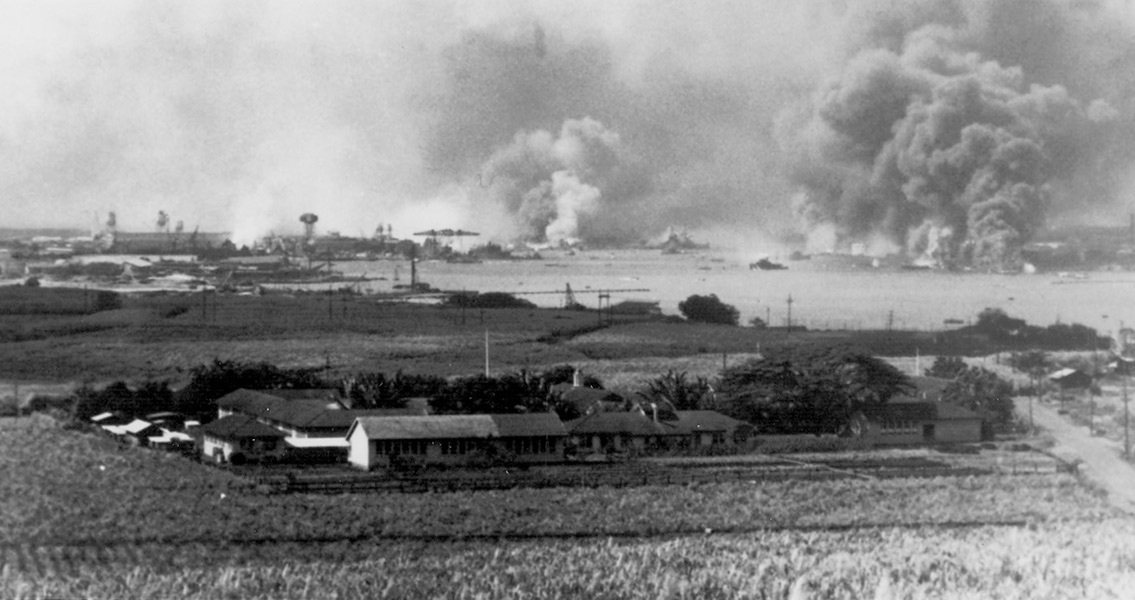<![CDATA[75 Years ago, on 7th December 1941, a devastating surprise attack was launched on Pearl Harbor, the US naval base on Hawaii. Just before 8am on the Sunday morning, a swarm of 353 Japanese aircraft descended from the sky and unleashed a barrage of bombs and bullets on the US Pacific fleet stationed on Oahu. In the space of just two hours, the Japanese force inflicted cataclysmic damage, obliterating twenty US naval vessels, including eight massive warships, and over three hundred aircraft. More than 2,000 US soldiers and sailors were killed and another 1,000 wounded. The effectiveness of the attack provides a sobering reminder of the nature of war in the 1940s. Setting sail on 29th November, an entire Japanese fleet including the biggest group of aircraft carriers ever assembled by that point, managed to sneak up on Pearl Harbor completely undetected. With no satellite coverage and RADAR still in its infancy, surprise attacks were much more achievable during the Second World War. The only way to detect fleet movements was with sea and airborne patrols. In many ways, the attack on Pearl Harbor could have been much worse for the US Navy. Fortunately, none of its fleet of aircraft carriers were in the harbor at the time, all of them either on exercises or stationed elsewhere. As the success of the Japanese attack hinted, aircraft carriers would prove vital in the war in the Pacific. Significantly, the US' entire contingent had made it through the first engagement unscathed. The Pearl Harbor attack's consequences quickly became apparent, and would totally alter the balance of the Second World War. Until December 1941 the USA had avoided direct involvement in the conflict that was tearing through Europe, Asia and Africa, its main contribution being bolstering the British war effort by shipping supplies across the Atlantic. The day after Pearl Harbor was attacked, President Franklin D. Roosevelt asked Congress to declare war on Japan; the declaration was quickly approved with just one dissenting vote. Three days later, Japan's allies Italy and Germany declared war on the USA, with Congress swiftly reciprocating. For two years the USA had stayed away from the fighting of the Second World War. In the space of just four days it was at war with all of the Axis powers. America's vast industrial and population resources thrown behind the Allied side. So, just how unexpected was the Japanese attack on Pearl Harbor? Conspiracy theorists have claimed that US intelligence knew the attack was coming, but opted to do nothing, allowing the images of the shocking devastation to cover front pages the next day to turn public opinion in the United States firmly in favour of entering the war. There is little concrete evidence to support this argument however, save for an encoded message intercepted by US intelligence that hinted at the Japanese plan. Generally, historians claim that it's only with hindsight this message pointed to an incoming attack; the US military had simply failed to grasp its significance. Japan and the USA had been edging towards war for quite some time however, even if the Japanese attack was an unexpectedly sudden escalation of hostilities. Throughout the 1930s the two nations had been embroiled in a conflict over influence in the Pacific region. Japan's invasion of China in 1937, and in particular the Nanking Massacre, turned US public opinion against Japan, and also brought Japan into conflict with troops from China's ally, the Soviet Union. The USA placed a host of tough economic sanctions and trade embargoes on Japan, hoping to halt its expansionism by strangling its supplies. Japan's resolve remained unbroken however, and it continued to expand through Asia and the Pacific. In July 1941, the tension between the countries reached breaking point. Japanese troops took Indochina, and the US responded by placing an oil embargo on Japan and freezing all Japanese assets. Japan was in an economic stranglehold, cut off from vital materials. With hindsight, it is perhaps obvious that Japan would respond, but at the time the country's resilience was hard to predict. Japan decided to invade the British and Dutch colonies in South East Asia to gain access to vital raw materials there, including oil. The attack on Pearl Harbor then, can be seen as the start of an audacious plan, or an act of desperation. The massive attack launched with the hope of disabling the US Pacific fleet; preventing it from responding to Japanese attacks on the British and Dutch territories. Ultimately, the Pearl Harbor attack failed to achieve its goals. The US was able to recover surprisingly quickly, and Japan could not resist its superior military strength. Within four years Japan would be defeated, its territorial gains in Asia and the Pacific all lost. ]]>
Pearl Harbor: 75 Years Since the Day that Lives in Infamy
